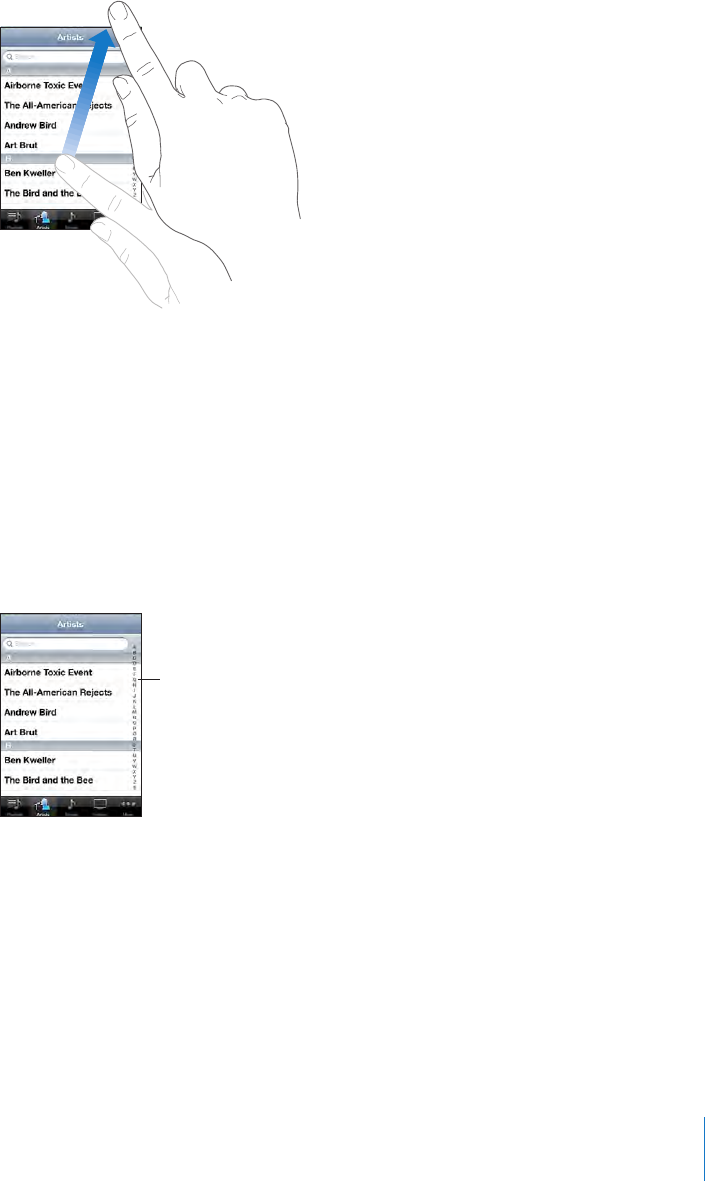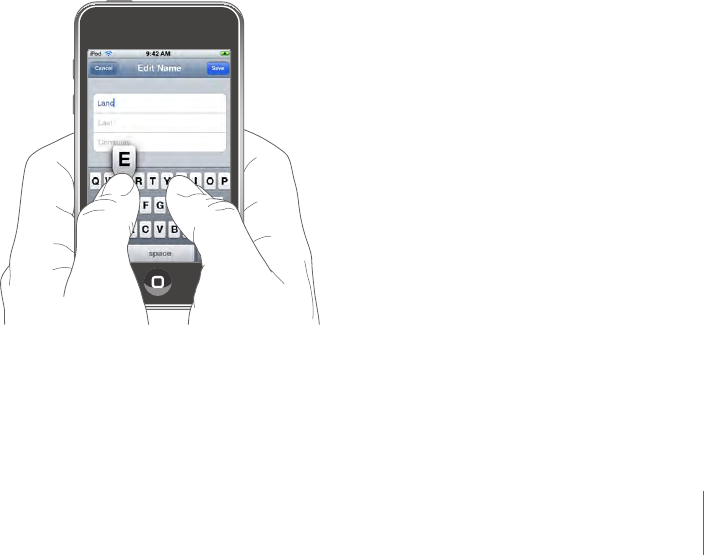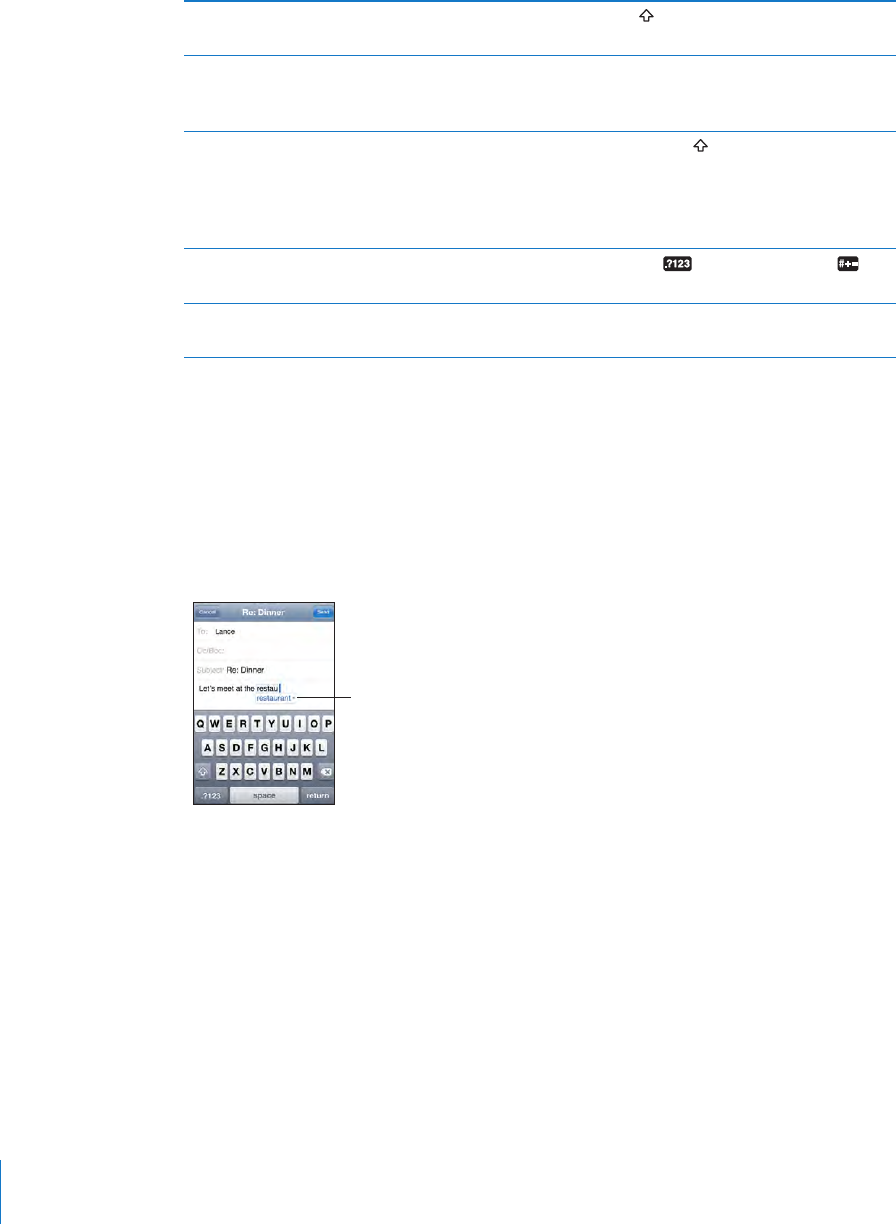Apple 2310 Handheld Device User Manual iPod touch User Guide
Apple Inc. Handheld Device iPod touch User Guide
Apple >
Contents
User Manual 1

iPod touch
User Guide
For iPhone OS 3.1 Software

Contents
7 Chapter 1: Getting Started
7 Viewing the User Guide on iPod touch
7 What You Need
8 Registering iPod touch
8 Setting Up iPod touch Using VoiceOver
9 Syncing
13 Mail, Contacts, and Calendar Accounts
15 Installing Conguration Proles
16 Disconnecting iPod touch from Your Computer
17 Chapter 2: Basics
17 iPod touch at a Glance
19 Home Screen
22 Buttons
24 Touchscreen
27 Onscreen Keyboard
32 Searching
33 Voice Control
34 Stereo Headset
34 Bluetooth Headphones
35 Connecting to the Internet
36 Battery
37 Security Features
38 Cleaning iPod touch
39 Restarting and Resetting iPod touch
40 Chapter 3: Music and Video
40 Getting Music, Video, and More
42 Music and Other Audio
50 Videos
54 Setting a Sleep Timer
54 Changing the Browse Buttons
2

55 Chapter 4: Safari
55 Viewing Webpages
58 Searching the Web
58 Bookmarks
59 Web Clips
60 Chapter 5: App Store
60 About the App Store
60 Browsing and Searching
62 Info Screen
63 Downloading Applications
64 Deleting Applications
64 Writing Reviews
65 Updating Applications
65 Syncing Purchased Applications
66 Chapter 6: Mail
66 Setting Up Email Accounts
66 Sending Email
67 Checking and Reading Email
71 Searching Email
71 Organizing Email
73 Chapter 7: Calendar
73 About Calendar
73 Syncing Calendars
74 Viewing Your Calendar
75 Searching Calendars
75 Subscribing to and Sharing Calendars
76 Adding Calendar Events to iPod touch
77 Responding to Meeting Invitations
78 Alerts
79 Chapter 8: Photos
79 About Photos
79 Syncing Photos and Videos with Your Computer
79 Viewing Photos and Videos
81 Slideshows
81 Sharing Photos and Videos
83 Assigning a Photo to a Contact
83 Wallpaper
84 Chapter 9: Contacts
84 Adding Contacts
3
Contents

85 Searching Contacts
85 Managing Contacts on iPod touch
86 Chapter 10: YouTube
86 Finding and Viewing Videos
87 Controlling Video Playback
88 Managing Videos
89 Getting More Information
89 Using YouTube Account Features
90 Changing the Browse Buttons
91 Chapter 11: Stocks
91 Viewing Stock Quotes
92 Getting More Information
93 Chapter 12: Maps
93 Finding and Viewing Locations
97 Bookmarking Locations
97 Getting Directions
99 Showing Trac Conditions
99 Finding and Contacting Businesses
101 Chapter 13: Weather
101 Viewing Weather Summaries
102 Getting More Weather Information
103 Chapter 14: Voice Memos
103 Recording Voice Memos
104 Listening to Voice Memos
104 Managing Voice Memos
105 Trimming Voice Memos
106 Sharing Voice Memos
106 Syncing Voice Memos
107 Chapter 15: Notes
107 Writing and Reading Notes
107 Searching Notes
108 Emailing Notes
108 Syncing Notes
109 Chapter 16: Clock
109 World Clocks
110 Alarms
110 Stopwatch
4Contents

111 Timer
112 Chapter 17: Calculator
112 Using the Calculator
112 Standard Memory Functions
113 Scientic Calculator Keys
115 Chapter 18: Settings
115 Wi-Fi
116 VPN
116 Notications
116 Brightness
117 General
123 Music
124 Video
124 Photos
125 Store
125 Mail, Contacts, Calendars
129 Safari
130 Nike + iPod
131 Chapter 19: iTunes Store
131 About the iTunes Store
132 Finding Music, Videos, and More
133 Purchasing Music or Audiobooks
133 Purchasing or Renting Videos
134 Streaming or Downloading Podcasts
135 Checking Download Status
135 Syncing Purchased Content
135 Changing the Browse Buttons
136 Viewing Account Information
136 Verifying Purchases
137 Chapter 20: Nike + iPod
137 Activating Nike + iPod
138 Additional Nike + iPod Settings
139 Chapter 21: Accessibility
139 Accessibility Features
140 VoiceOver
146 Zoom
147 White on Black
147 Mono Audio
147 Speak Auto-text
5
Contents

148 Triple-click Home
148 Closed Captioning and Other Helpful Features
150 Appendix A: Troubleshooting
150 Apple iPod touch Support Site
150 General
151 iTunes and Syncing
152 Sound, Music, and Video
153 iTunes Stores
154 Safari, Mail, and Contacts
156 Backing Up iPod touch
158 Updating and Restoring iPod touch Software
159 Appendix B: Other Resources
159 Safety, Software, and Service Information
160 Viewing the User Guide on iPod touch
160 Disposal and Recycling Information
161 Apple and the Environment
162 Index
6Contents

Getting Started 1
·WARNING: To avoid injury, read all operating instructions in this guide and
safety information in the iPod touch Important Product Information Guide at
www.apple.com/support/manuals/ipodtouch before using iPod touch.
Viewing the User Guide on iPod touch
The iPod touch User Guide, optimized for viewing on iPod touch, is available at help.
apple.com/ipodtouch.
View the guide on iPod touch: In Safari, tap , then tap the iPod touch User Guide
bookmark.
Add an icon for the guide to the Home screen: When viewing the guide, tap ,
then tap “Add to Home Screen.”
The iPod touch User Guide is available in many languages.
View the guide in a dierent language: Tap “Change Language” at the bottom of the
screen on the main contents page, then choose the language you want.
What You Need
To use iPod touch, you need:
A Mac or a PC with a USB 2.0 port and one of the following operating systems:•
Mac OS X version 10.4.11 or later; version 10.5.7 or later is required for •
syncing Notes
Windows XP Home or Professional with Service Pack 3 or later•
Windows Vista Home Premium, Business, Enterprise, or Ultimate edition•
Display resolution on your computer set to 1024 x 768 or higher•
iTunes 9 or later, available at • www.itunes.com/download
QuickTime 7.6.2 or later•
An iTunes Store account (for purchases from the iTunes Store or App Store)•
An Internet connection for your computer (broadband recommended)•
7

Registering iPod touch
Before you can use any of the iPod touch features, you must use iTunes to set up
iPod touch. You can also register iPod touch and create an iTunes Store account
(not available in some countries) if you don’t already have one.
Register iPod touch:
1 Download and install the latest version of iTunes from www.itunes.com/download.
2 Connect iPod touch to a USB 2.0 port on your Mac or PC using the cable that came
with iPod touch.
3 Follow the onscreen instructions in iTunes to register iPod touch and sync iPod touch
with music, video, and other content from your iTunes library, and with your contacts,
calendars, and bookmarks on your computer.
Setting Up iPod touch Using VoiceOver
If you’re visually impaired, VoiceOver (available only on Fall 2009 models with 32 GB
or more) can help you set up iPod touch without a sighted assistant. VoiceOver
describes aloud what appears on the screen, so you can use iPod touch without seeing
it. When you connect iPod touch to your computer, iTunes detects whether you’re
using a compatible screen reader on your computer, such as VoiceOver on a Mac or
GW Micro Window-Eyes on a PC, and automatically enables VoiceOver on iPod touch.
A sighted user can also enable VoiceOver on iPod touch for you, using Accessibility
settings. See “Using VoiceOver” on page 14 4.
Note: VoiceOver isn’t available in all languages.
8Chapter 1 Getting Started

Syncing
About Syncing
With iPod touch, it’s easy to have instant access to your music, video, downloaded
applications, and other iTunes library content. iTunes can sync all this information to
iPod touch, and your contacts, calendars, and your browser bookmarks as well.
iTunes lets you specify the information and content on your computer that you
want to sync with iPod touch. By default, iTunes syncs automatically with iPod touch
whenever you connect iPod touch to your computer.
Syncing with iTunes
You can set iTunes to sync any or all of the following:
Music and audiobooks•
Movies•
TV Shows•
Games and applications downloaded from the iTunes Store•
Music videos•
Podcasts•
iTunes U collections•
Photos and videos (in your computer’s photo application or folder)•
Contacts—names, phone numbers, addresses, email addresses, and more•
Calendars—appointments and events•
Notes (requires Mac OS X version 10.5.7 or later on a Mac, or Microsoft Outlook 2003 •
or 2007 on a PC)
Email account settings•
Webpage bookmarks•
You can adjust sync settings whenever iPod touch is connected to your computer.
Music, audiobooks, podcasts, iTunes U collections, videos, and applications can be
synced from your iTunes library. If you don’t already have content in iTunes, the iTunes
Store (available in some countries) makes it easy to preview and download content
to iTunes. You can also add music to your iTunes library from your CDs. To learn about
iTunes and the iTunes Store, open iTunes and choose Help > iTunes Help.
Contacts, calendars, notes, and webpage bookmarks are synced with applications
on your computer, as described in the following section. Contacts and calendars are
synced both ways between your computer and iPod touch. New entries or changes
you make on iPod touch are synced to your computer, and vice versa. Notes and
webpage bookmarks are also synced both ways. Photos and videos (Mac only) can be
synced from an application or from a folder.
9
Chapter 1 Getting Started

Email account settings are synced only from your computer’s email application to
iPod touch. This allows you to customize your email accounts on iPod touch without
aecting email account settings on your computer.
Note: You can also set up email accounts directly on iPod touch. See “Mail, Contacts,
and Calendar Accounts.”
Purchases you make on iPod touch in the iTunes Store or the App Store are synced
back to your iTunes library. You can also purchase or download content and
applications directly from the iTunes Store on your computer, and then sync them to
iPod touch.
You can set iPod touch to sync with only a portion of what’s on your computer.
For example, you might want to sync only certain music playlists, or only unwatched
video podcasts.
Important: You should be logged in to your own computer user account before
connecting iPod touch.
Set up iTunes syncing:
1 Connect iPod touch to your computer, and open iTunes (if it doesn’t open
automatically).
2 In iTunes, select iPod touch in the sidebar.
3 Congure the sync settings in each of the settings panes.
See the following section for descriptions of the panes.
4 Click Apply in the lower-right corner of the screen.
By default, “Open iTunes when this iPod is connected” is selected.
iPod touch Settings Panes in iTunes
The following sections provide an overview of each of the iPod touch settings panes.
For more information, open iTunes and choose Help > iTunes Help.
10 Chapter 1 Getting Started

Summary Pane
Select “Open iTunes when this iPod is connected” to have iTunes open and sync
iPod touch automatically whenever you connect it to your computer. Deselect
this option if you want to sync only by clicking the Sync button in iTunes. For
more information about preventing automatic syncing, see “Preventing Automatic
Syncing” on page 13 .
Select “Sync only checked songs and videos” if you want iTunes to skip unchecked
items in your iTunes library when syncing.
Select “Manually manage music and videos” to turn o automatic syncing in the Music
and Video settings panes. See “Manually Managing Content” on page 41.
Select “Encrypt iPod backup” if you want to encrypt the information stored on your
computer when iTunes makes a backup. Encrypted backups are indicated by a padlock
icon, and a password is required to restore the information to iPod touch. See “Backing
Up iPod touch” on page 156.
Click Congure Universal Access to turn on Accessibility features (available only on Fall
2009 models with 32 GB or more). See Chapter 21, “Accessibility,” on page 139.
Applications Pane
Use the Applications pane to specify which App Store applications to sync
on iPod touch, or to arrange your Home screen (requires iTunes 9 or later).
Any applications downloaded directly to iPod touch are automatically backed up
to your iTunes library when you sync. If you manually delete an application on
iPod touch, you can reinstall it from this pane as long as it was previously synced.
Music, Movies, TV Shows, Podcasts, and iTunes U Panes
Use these panes to specify the media you want to sync. You can sync all music, movies,
TV shows, podcasts, and iTunes U collections, or select the content you want on
iPod touch.
If you want to watch rented movies on iPod touch, transfer them to iPod touch using
the Movies pane in iTunes.
If there’s not enough room on iPod touch for all the media you’ve specied, iTunes can
create a special playlist and set it to sync with iPod touch.
Note: The iTunes U pane appears only in iTunes 9 or later. In earlier versions of iTunes,
iTunes U content appeared in the Podcasts pane.
Photos Pane
You can sync photos and videos (Mac only, iTunes 9 required) with iPhoto 4.0.3 or later,
or Aperture on a Mac; or with Adobe Photoshop Elements 3.0 or later on a PC. You can
also sync photos and videos in any folder on your computer that contains images.
11
Chapter 1 Getting Started

Info Pane
The Info pane lets you congure the sync settings for your contacts, calendars, email
accounts, and web browser.
Contacts•
You can sync contacts with applications such as Mac OS X Address Book, Yahoo!
Address Book, and Google Contacts on a Mac, or with Yahoo! Address Book, Google
Contacts, Windows Address Book (Outlook Express), Windows Vista Contacts, or
Microsoft Outlook 2003 or 2007 on a PC. (On a Mac, you can sync contacts with
multiple applications. On a PC, you can sync contacts with only one application at
a time.)
If you sync with Yahoo! Address Book, you only need to click Congure to enter your
new login information when you change your Yahoo! ID or password after you’ve
set up syncing.
Calendars•
You can sync calendars from applications such as iCal on a Mac, or from Microsoft
Outlook 2003 or 2007 on a PC. (On a Mac, you can sync calendars with multiple
applications. On a PC, you can sync calendars with only one application at a time.)
Web Browser•
You can sync bookmarks from Safari on a Mac, or from Safari or Microsoft Internet
Explorer on a PC.
Notes•
Sync notes in the Notes application on iPod touch with notes in Mail on a Mac or
with Microsoft Outlook 2003 or 2007 on a PC. (On a Mac, you must have Mac OS
version 10.5.7 or later installed to sync notes.)
Mail Accounts•
You can sync email account settings from Mail on a Mac, and from Microsoft
Outlook 2003 or 2007 or Outlook Express on a PC. Account settings are only
transferred from your computer to iPod touch. Changes you make to an email
account on iPod touch don’t aect the account on your computer.
Note: The password for your Yahoo! email account isn’t saved on your computer,
so it can’t be synced and must be entered on iPod touch. In Settings, choose “Mail,
Contacts, Calendars,” tap your Yahoo! account, and enter the password.
Advanced•
These options let you replace the information on iPod touch with the information
on your computer during the next sync.
12 Chapter 1 Getting Started

Preventing Automatic Syncing
You can prevent iPod touch from syncing automatically when you connect iPod touch
to a computer other than the one you usually sync with.
Turn o automatic syncing for iPod touch: Connect iPod touch to your computer.
In iTunes, select iPod touch in the sidebar, then click the Summary tab. Deselect “Open
iTunes when this iPod is connected.” You can still sync by clicking the Sync button.
Prevent automatic syncing for all iPhones and iPods: In iTunes choose iTunes >
Preferences (on a Mac) or Edit > Preferences (on a PC), click Devices, and select “Disable
automatic syncing for all iPhones and iPods.”
If this checkbox is selected, iPod touch won’t sync automatically, even if “Open iTunes
when this iPod is connected” is selected in the Summary pane.
Prevent automatic syncing one time, without changing settings: Open iTunes,
connect iPod touch to your computer, then press and hold Command-Option (on a
Mac) or Shift-Control (on a PC) until you see iPod touch appear in the sidebar.
Sync manually: In iTunes, select iPod touch in the sidebar, then click Sync in the
bottom-right corner of the window. Or, if you’ve changed any sync settings, click Apply.
Mail, Contacts, and Calendar Accounts
iPod touch works with MobileMe, Microsoft Exchange, and many of the most popular
email systems.
Setting Up Accounts
MobileMe and Microsoft Exchange provide not only email, but contact and calendar
information that can be synced to iPod touch automatically, over the air. MobileMe
can also sync your bookmarks on iPod touch with Safari on a Mac, or with Safari or
Microsoft Internet Explorer on a PC. You set up MobileMe, Exchange, and other email
accounts directly on iPod touch.
iPod touch uses the Exchange ActiveSync protocol to sync email, calendars, and
contacts with the following versions of Microsoft Exchange:
Exchange Server 2003 Service Pack 2•
Exchange Server 2007 Service Pack 1•
For many popular email accounts, iPod touch automatically enters most of the settings
for you.
If you don’t already have an email account, you can get a free account online at
www.yahoo.com, www.google.com, or www.aol.com. You can also try MobileMe,
free for 60 days. Go to www.me.com.
13
Chapter 1 Getting Started

Set up an account on iPod touch:
1 From the iPod touch Home screen, tap Settings.
2 Tap “Mail, Contacts, Calendars,” then tap Add Account.
3 Tap an account type:
Microsoft Exchange•
MobileMe•
Google email•
Yahoo! Mail•
AOL•
Other•
4 Enter your account information and tap Save.
Your service provider or system administrator can provide the account settings
you need.
Exchange accounts: Enter your complete email address, domain (optional), user name,
password, and a description. The description can be whatever you like.
iPod touch supports Microsoft’s Autodiscovery service, which uses your user name
and password to determine the address of the Exchange server. If the server’s address
can’t be determined, you’re asked to enter it. (Enter the complete address in the Server
eld.) Once you connect to the Exchange server, you may be prompted to change your
passcode to match the policies set on the server.
5 If you’re setting up a MobileMe or Microsoft Exchange account, tap the items you want
to use on iPod touch—mail, contacts, calendars, and bookmarks (MobileMe only).
MobileMe includes the Find My iPod touch feature that helps you locate iPod touch if
it’s been lost or stolen, and remotely lock, set a passcode, or erase the information on
iPod touch if necessary. See “Security Features” on page 37.
If you enable Find My iPod touch for your MobileMe account, make sure that Push is
turned on for Fetch New Data. In Settings, choose “Mail, Contacts, Calendars” > Fetch
New Data, and if Push is o, tap to turn it on.
For Exchange accounts, you can set how many days of email you want to sync to
iPod touch.
If you already have contact or calendar information on iPod touch when you enable
the account, iPod touch asks what you want to do with existing information on
iPod touch. You can choose to merge the existing data into your MobileMe or
Exchange account. If you don’t merge the data, you can choose to keep it in a separate
account on iPod touch (the account is labeled “On My iPod touch”), or delete it.
Existing bookmarks can only be merged or deleted.
14 Chapter 1 Getting Started

Similarly, when you disable contacts or calendars in an MobileMe or Exchange
account, or if you delete an account, iPod touch asks if you want to keep information
or delete it.
You can add contacts using an LDAP account if your company or organization
supports it. See “Adding Contacts” on page 84.
You can subscribe to CalDAV or iCal (.ics) calendars. See “Subscribing to and Sharing
Calendars” on page 75.
Push Accounts
MobileMe, Microsoft Exchange, and Yahoo! Mail are known as “push” accounts. When
new information is available, such as the arrival of an email message, the information
is automatically delivered (pushed) to iPod touch. (In contrast, “fetch” services require
your email software to periodically check with your service provider to see if new
messages have arrived, and then request them to be delivered.) MobileMe and
Exchange also use push to sync your contacts, calendars, and bookmarks (MobileMe
only) if you have those items selected in the account settings.
Synced information is transferred automatically over your wireless connection; you
don’t need to connect iPod touch to your computer to sync. iPod touch can receive
pushed data over a Wi-Fi connection only when iPod touch is awake (the screen is on,
or iPod touch is connected to your computer or a power adapter).
Installing Conguration Proles
If you’re in an enterprise environment, you may be able to set up accounts and
other items on iPod touch by installing a conguration prole. Conguration proles
provide a way for system administrators to quickly set up your iPod touch to work
with the information systems at your company, school, or organization. For example,
a conguration prole might set up your iPod touch to access the Microsoft Exchange
servers at work, enabling iPod touch to access your Exchange email, calendars,
and contacts.
Conguration proles can congure multiple settings on iPod touch all at once. For
example, a conguration prole can set up your Microsoft Exchange account, VPN
account, and certicates for secure access to your company’s network and information.
A conguration prole may turn on the Passcode Lock, requiring you to create and
enter a passcode for using iPod touch.
Your system administrator may distribute conguration proles by email or by putting
them on a secure webpage. A system administrator may also install a conguration
prole directly on iPod touch for you.
15
Chapter 1 Getting Started

Install a conguration prole:
1 Using iPod touch, open the email message or download the conguration prole from
the website provided by your system administrator.
2 When the conguration prole opens, tap Install.
3 Enter passwords and other information as requested.
Important: You may be asked to verify that the conguration prole is trusted. If in
doubt, consult your system administrator before installing a conguration prole.
Settings provided by a conguration prole cannot be altered. If you want to change
these settings, you must rst remove the conguration prole or install an updated
conguration prole.
Remove a prole: In Settings, choose General > Prole, then select the conguration
prole and tap Remove.
Removing a conguration prole deletes the settings and all other information
installed by the conguration prole from iPod touch.
Disconnecting iPod touch from Your Computer
Unless iPod touch is syncing with your computer, you can disconnect it from your
computer at any time.
When iPod touch is syncing with your computer, iPod touch shows “Sync in progress.”
If you disconnect iPod touch before it nishes syncing, some data may not get
transferred. When iPod touch nishes syncing, iTunes shows “iPod touch sync is
complete.”
Cancel a sync: Drag the slider on iPod touch.
16 Chapter 1 Getting Started

Basics 2
iPod touch at a Glance
Sleep/Wake
button
Volume
buttons
Headphones
port
Dock
connector
Wi-Fi antenna
Home
button
Internal
speaker
Touchscreen
Application
icons
Status bar
Your Home screen may look dierent, depending on the model of iPod touch you have
and whether you have rearranged its icons.
iPod touch Included Accessories
Dock Connector to USB Cable
Stereo headset
17

Item What you can do with it
Apple Earphones with Remote and Mic (Fall
2009 models with 32 GB or more)
Apple Earphones (8 GB model)
Listen to music, audiobooks, podcasts, and videos.
Use the built-in microphone to speak. Press the
center button to play or pause a song, or press
twice quickly to skip to the next track. Use the
+ and – buttons to adjust the volume (Apple
Earphones with Remote and Mic included only
with Fall 2009 models with 32 GB or more). Press
and hold the center button to use Voice Control
(available only on Fall 2009 models with 32 GB
or more).
Dock Connector to USB Cable Use the cable to connect iPod touch to your
computer to sync and charge, or to the USB
power adapter (sold separately) to charge. The
cable can be used with the optional dock or
plugged directly into iPod touch.
Status Icons
The icons in the status bar at the top of the screen give information about iPod touch:
Status icon What it means
Wi-Fi Shows that iPod touch is connected to the
Internet over a Wi-Fi network. The more bars,
the stronger the connection. See “Joining a Wi-Fi
Network” on page 35.
Network activity Shows network activity. Some third-party
applications may also use this icon to indicate an
active process.
VPN Shows that you are connected to a network using
VPN. See “Network” on page 117.
Lock Shows that iPod touch is locked. See “Sleep/Wake
Button.”
Play Shows that a song, audiobook, or podcast is
playing. See “Playing Songs” on page 42.
Alarm Shows that an alarm is set. See “Alarms” on
page 110 .
Bluetooth Blue or white icon: Bluetooth® (not available on
rst-generation iPod touch) is on and a device,
such as a headset, is connected. Gray icon:
Bluetooth is on, but no device is connected.
No icon: Bluetooth is turned o.
Battery Shows battery level or charging status.
See “Charging the Battery” on page 36.
18 Chapter 2 Basics

Home Screen
Press the Home button at any time to go to the Home screen, which contains your
iPod touch applications. Tap any application icon to get started.
iPod touch Applications
The following applications are included with iPod touch:
Music
Listen to your songs, audiobooks, and podcasts. Create on-the-go playlists, or use
Genius to create playlists for you. Listen to Genius Mixes of songs from your library.
Videos
Watch purchased or rented movies, music videos, video podcasts, and TV shows on
the go. Or connect iPod touch to your TV to watch on a larger screen (TV connection
requires cable available for purchase separately).
Safari
Browse websites over Wi-Fi. Rotate iPod touch sideways for widescreen viewing.
Double-tap to zoom in or out—Safari automatically ts the webpage column to the
iPod touch screen for easy reading. Open multiple pages. Sync bookmarks with Safari
or Microsoft Internet Explorer on your computer. Add Safari web clips to the Home
screen for fast access to favorite websites. Save images from websites to your Photo
Library.
App Store
Search the App Store for iPod touch applications you can purchase or download using
your Wi-Fi connection. Read reviews or write your own reviews for your favorite apps.
Download and install the applications on your Home screen.
Mail
iPod touch works with MobileMe, Microsoft Exchange, and many of the most popular
email systems—including Yahoo! Mail, Google email, and AOL—as well as most
industry-standard POP3 and IMAP email systems. View PDFs and other attachments
within Mail. Save attached photos and graphics to your Photo Library.
Calendar
View and search your MobileMe, iCal, Microsoft Entourage, Microsoft Outlook, or
Microsoft Exchange calendars. Enter events on iPod touch and they get synced back
to the calendar on your computer. Subscribe to calendars. Set alerts to remind you of
events, appointments, and deadlines.
Photos
View photos and videos (only on Fall 2009 models with 32 GB or more) received in Mail
messages, or synced from your computer’s photo application (video syncing on Macs
only). View them in portrait or landscape mode. Zoom in on photos for a closer look.
Watch a slideshow. Email photos and videos, or publish them to MobileMe galleries.
Assign images to contacts, and use them as wallpaper.
19
Chapter 2 Basics

Contacts
Get contact information synced from MobileMe, Mac OS X Address Book, Yahoo!
Address Book, Google Contacts, Windows Address Book (Outlook Express), Microsoft
Outlook, or Microsoft Exchange. Search, add, change, or delete contacts, which get
synced back to your computer.
YouTube
Play videos from YouTube’s online collection. Search for any video, or browse featured,
most viewed, most recently updated, and top-rated videos. Set up and log in to your
YouTube account—then rate videos, sync your favorites, show subscriptions, and more.
Stocks
Watch your favorite stocks, updated automatically from the Internet. View company
news and current trading information, such as opening or average price, trading
volume, or market capitalization. Rotate iPod touch to see detailed charts in landscape
orientation. Drag your nger along the charts to track price points, or use two ngers
to see a range between points.
Maps
See a street map, satellite view, or hybrid view of locations around the world. Zoom in
for a closer look, or check out the Google Street View. Find your current approximate
location. Get detailed driving, public transit, or walking directions and see current
highway trac conditions. Find businesses in the area.
Weather
Get current weather conditions and a six-day forecast. Add your favorite cities for a
quick weather report anytime.
Voice
Memos
Record voice memos on iPod touch. (Requires a compatible external microphone or
headset with microphone. Not available on rst-generation iPod touch.) Play them back
on iPod touch or sync them with iTunes to listen to voice memos on your computer.
Attach voice memos to email messages.
Notes
Jot notes on the go—reminders, grocery lists, brilliant ideas. Send them in email.
Clock
View the time in cities around the world—create clocks for your favorites. Set one or
more alarms. Use the stopwatch, or set a countdown timer.
20 Chapter 2 Basics

Calculator
Add, subtract, multiply, and divide. Rotate iPod touch sideways to use expanded
scientic functions.
Settings
Adjust all iPod touch settings in one convenient place. Set your own volume limit for
listening comfort. Set your wallpaper, screen brightness, and settings for network, mail,
web, music, video, photos, and more. Set auto-lock and a passcode for security. Restrict
access to explicit iTunes content and certain applications. Reset iPod touch.
iTunes
Search the iTunes Store for music, audiobooks, TV shows, music videos, and movies.
Browse, preview, purchase, and download new releases, top items, and more. Rent
movies to view on iPod touch. Stream and download podcasts. Read reviews or write
your own reviews for your favorite store items.
Nike + iPod
When activated in Settings, Nike + iPod turns your iPod touch into a workout
companion. Track your pace, time, and distance from one workout to the next and
choose a song to power through your routine. (Requires select Nike shoes and a Nike +
iPod Sensor, sold separately. Not available on rst-generation iPod touch.)
Note: Application functionality and availability may vary depending on the country or
region where you purchase and use iPod touch.
Customizing the Home Screen
You can customize the layout of icons on the Home screen—including the Dock
icons along the bottom of the screen. If you want, arrange them over multiple Home
screens.
Rearrange icons:
1 Touch and hold any Home screen icon until the icons begin to wiggle.
2 Arrange the icons by dragging them.
3 Press the Home button to save your arrangement.
You can also add links to your favorite webpages on the Home screen. See “Web
Clips” on page 59.
You can also rearrange the Home screen icons and the order of the screens (in iTunes
9 or later) when iPod touch is connected to your computer. Select iPod touch in the
iTunes sidebar, then click the Applications tab.
21
Chapter 2 Basics

Create additional Home screens: While arranging icons, drag an icon to the right
edge of the screen until a new screen appears. You can ick to return to the original
screen and drag more icons to the new screen.
You can create up to 11 screens. The number of dots above the Dock shows the
number of screens you have, and indicates which screen you’re viewing.
Switch to another Home screen: Flick left or right, or tap to the left or right of the row
of dots.
Go to the rst Home screen: Press the Home button.
Reset your Home screen to the default layout: Choose Settings > General > Reset
and tap Reset Home Screen Layout.
Buttons
A few simple buttons make it easy to turn iPod touch on and o, and adjust the
volume.
Sleep/Wake Button
When you’re not using iPod touch you can lock it.
When iPod touch is locked, nothing happens if you touch the screen. You can still
listen to music and adjust the volume, and use the center button on your iPod touch
headset (or the equivalent button on your Bluetooth headset) to play or pause a song.
By default, if you don’t touch the screen for a minute, iPod touch locks automatically.
Sleep/Wake
button
22 Chapter 2 Basics

Lock iPod touch Press the Sleep/Wake button.
Unlock iPod touch Press the Home button or the Sleep/Wake
button, then drag the slider.
Turn iPod touch completely o Press and hold the Sleep/Wake button for a few
seconds until the red slider appears, then drag
the slider.
Turn iPod touch on Press and hold the Sleep/Wake button until the
Apple logo appears.
For information about changing how long before iPod touch locks, see “Auto-Lock” on
page 118 . For information about setting iPod touch to require a passcode to unlock it,
see “Passcode Lock” on page 119 .
Volume Buttons
When you’re listening to songs, movies, or other media, the buttons on the side of
iPod touch adjust the audio volume. Otherwise, the buttons control the volume for
alerts and other sound eects.
Note: Volume buttons aren’t included on the rst-generation iPod touch.
WARNING: For important information about avoiding hearing loss, see the Important
Product Information Guide at www.apple.com/support/manuals/ipodtouch.
To adjust the volume, use the buttons on the side of iPod touch.
Volume
up
Volume
down
To set a volume limit for music and videos on iPod touch, see “Music” on page 123.
23
Chapter 2 Basics

Touchscreen
The controls on the iPod touch touchscreen change dynamically depending on the
task you’re performing.
Opening Applications
Open an application: Tap an icon.
Close an application and return to the Home screen: Press the Home button
below the display.
Scrolling
Drag up or down to scroll. On some screens such as webpages, you can also scroll side
to side.
Dragging your nger to scroll won’t choose or activate anything on the screen.
24 Chapter 2 Basics

Flick to scroll quickly.
You can wait for the scrolling to come to a stop, or touch anywhere on the screen to
stop it immediately. Touching the screen to stop scrolling won’t choose or activate
anything.
To quickly scroll to the top of a list, webpage, or email, just tap the status bar.
Lists
Some lists have an index along the right side, which helps you navigate quickly.
Find items in an indexed list: Tap a letter to jump to items starting with that letter.
Drag your nger along the index to scroll quickly through the list.
Index
Choose an item: Tap an item in the list.
Depending on the list, tapping an item can do dierent things—for example, it may
open a new list, play a song, open an email, or show someone’s contact information.
Return to a previous list: Tap the back button in the upper-left corner.
25
Chapter 2 Basics

Zooming In or Out
When viewing photos, webpages, email, or maps, you can zoom in and out. Pinch your
ngers together or apart. For photos and webpages, you can double-tap (tap twice
quickly) to zoom in, then double-tap again to zoom out. For maps, double-tap to zoom
in and tap once with two ngers to zoom out.
Viewing in Landscape
Many iPod touch applications let you view the screen in either portrait or landscape
orientation. Rotate iPod touch and the display rotates too, adjusting automatically to
t the new screen orientation.
You may prefer landscape for viewing webpages in Safari, or when entering text, for
example. Webpages automatically scale to the wider screen in landscape, making the
text and images larger. Similarly, the onscreen keyboard is larger in landscape, which
may help increase your typing speed and accuracy.
The following applications support both portrait and landscape orientation:
Music and Video•
Mail•
Safari•
Notes•
Contacts•
26 Chapter 2 Basics

Stocks•
Photos•
Calculator•
Movies viewed in Video and YouTube appear only in landscape orientation. Street
views in Maps also appear in landscape.
Onscreen Keyboard
Use the onscreen keyboard to enter text, such as contact information and web
addresses.
Typing
Depending on the application you’re using, the intelligent keyboard may automatically
suggest corrections as you type to help prevent mistyped words.
Enter text:
1 Tap a text eld, such as in a note or new contact, to bring up the keyboard.
2 Tap keys on the keyboard.
Start by typing with just your index nger. As you get more procient, you can type
more quickly using two thumbs.
As you type, each letter appears above your thumb or nger. If you touch the wrong
key, you can slide your nger to the correct key. The letter isn’t entered until you
release your nger from the key.
27
Chapter 2 Basics

Type uppercase Tap the Shift key before tapping a letter. Or
touch and hold the Shift key, then slide to a letter.
Quickly type a period and space Double-tap the space bar. (You can turn
this feature on or o in Settings > General >
Keyboard.)
Turn caps lock on Double-tap the Shift key. The Shift key turns
blue, and all letters you type are uppercase. Tap
the Shift key again to turn caps lock o. (You can
turn this feature on or o in Settings > General >
Keyboard.)
Show numbers, punctuation, or symbols Tap the Number key. Tap the Symbol key
to see additional punctuation and symbols.
Type letters or symbols that aren’t on the
keyboard
Touch and hold the related letter or symbol, then
slide to choose a variation.
Dictionary
For many languages, iPod touch has dictionaries to help you type. The appropriate
dictionary is activated automatically when you select a supported keyboard.
For a list of supported languages, see www.apple.com/ipodtouch/specs.html.
iPod touch uses the active dictionary to suggest corrections or complete the word
you’re typing. You don’t need to interrupt your typing to accept the suggested word.
Suggested
word
Accept or reject dictionary suggestions:
mTo reject the suggested word, nish typing the word as you want it, then tap the “x” to
dismiss the suggestion before typing anything else. Each time you reject a suggestion
for the same word, iPod touch becomes more likely to accept your word.
mTo use the suggested word, type a space, punctuation mark, or return character.
Turn Auto-Correction on or o: Choose General > Keyboard and turn Auto-Correction
on or o. Auto-Correction is on by default.
Note: If you’re entering Chinese or Japanese, tap one of the suggested alternatives.
28 Chapter 2 Basics

Editing
An onscreen magnifying glass helps you position the insertion point for typing and
editing text. You can select text to cut, copy, and paste.
Position the insertion point: Touch and hold to bring up the magnifying glass,
then drag to position the insertion point.
Select text: Tap the insertion point to display the selection buttons. Tap Select to
select the adjacent word or tap Select All to select all text. When you’re typing, you can
also double-tap to select a word. In read-only documents, such as webpages or email
you’ve received, touch and hold to select a word.
Drag the grab points to select more or less text.
Cut or copy text: Select text, then tap Cut or Copy.
Paste text: Tap the insertion point and tap Paste. The last text that you cut or copied is
inserted. Or select text and tap Paste to replace the text.
Undo the last edit: Shake iPod touch and tap Undo.
29
Chapter 2 Basics

International Keyboards
iPod touch provides keyboards that allow you to enter text in many dierent
languages, including languages that read from right to left. For a complete list of
supported keyboards, go to www.apple.com/ipodtouch/specs.html.
Turn international keyboards on or o:
1 In Settings, choose General > International > Keyboards.
2 Turn on the keyboards you want. Languages with more than one keyboard, such as
Japanese and Chinese, indicate the number of keyboards available. Tap to choose a
keyboard for that language.
Switch keyboards if more than one keyboard is
turned on
Tap to switch keyboards. When you tap
the symbol, the name of the newly activated
keyboard appears briey.
Type letters, numbers, or symbols that aren’t on
the keyboard
Touch and hold the related letter, number, or
symbol, then slide to choose a variation. On the
Hebrew and Thai keyboards, for example, you can
choose native numbers by touching and holding
the related Arabic number.
Enter Japanese Kana Use the Kana keypad to select syllables. For more
syllable options, tap the arrow key and select
another syllable or word from the window.
Enter Japanese QWERTY Use the QWERTY keyboard to input code for
Japanese syllables. As you type, suggested
syllables appear. Tap the syllable to choose it.
30 Chapter 2 Basics